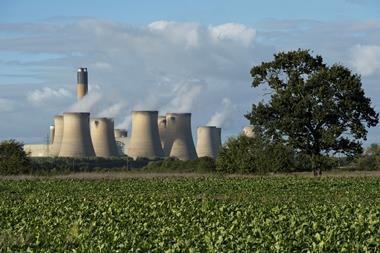One of the first composite materials whose production actually cuts carbon dioxide emissions over its life cycle has been created by researchers at Pacific Northwest National Laboratory (PNNL), US. The work was presented at the spring meeting of the American Chemical Society on 17 March.

Decking boards made from wood–plastic composite, instead of lumber, are a popular option since they have a longer lifespan. Usually, such composite materials consist of a blend of wood chips or sawdust and plastic like HDPE.
The PNNL team has developed a new carbon capture utilisation and storage approach to produce carbon-negative composites, comprised of lignin or lignite fillers. These fillers are functionalised with carbon dioxide using base-mediated Kolbe-Schmitt reactions to attach captured carbon dioxide to polyphenols on the lignite or lignin. An acid wash is then used on the particles to secure the carbon dioxide, which then makes up around 4% by weight of the fillers. These fillers are then mixed within a high-density polyethylene (HDPE) matrix – the fillers make up 80% by weight of the composite so are locking away significant quantities of carbon dioxide.
Their testing revealed that a composite containing 80% filler maximised carbon dioxide content while also demonstrating sufficient strength and durability to satisfy international building codes for decking materials. The material was manufactured via friction extrusion at PNNL, and the team used this material to make 10-foot-long composites that have a similar look and feel to standard wood composites used for decking or lawn furniture. It is also significantly more cost-effective, estimated to be 18% cheaper than typical composite decking.
Importantly, the new material stores more carbon dioxide than is released during its manufacture and life, according to one of the composite’s inventors David Heldebrant. If the 1.1 billion metres of decking sold in the US every year were replaced with this carbon-negative composite decking, he estimated that more than 230,000 tonnes of carbon dioxide could be sequestered each year. That figure is equal to the annual emissions from about 54,000 cars.
‘So, this isn’t just a small niche product, this would have the potential to remove essentially 50,000-plus cars’ annual emissions just in the decking market alone,’ Heldebrant remarked. A longstanding challenge has been to find a product that is carbon-negative, can be stored for a long period of time and can turn a profit. ‘In this product, we believe that we have the solution,’ he said.
Heldebrant’s team is working on commercialising its carbon-negative decking boards and it is estimated that they might be available from building suppliers as soon as next summer. The researchers also aim to make other composite formulations and test their properties, with the goal of developing carbon-negative composites for various kinds of building materials, including fencing and siding.
Maksud Rahman, a materials scientist at Rice University in Texas who was not involved in this research but last year was part of a team that created engineered wood capable of trapping carbon dioxide by incorporating a metal–organic framework, is optimistic. ‘It seems to me that from the fabrication perspective the composite decking idea is innovative,’ he says. ‘The materials are sustainable and recyclable, so we can say the composite is carbon-neutral and less expensive due to use of low-value or waste products such as lignin and coal.’
In addition, he says the abundance of the materials means the production could be scalable and is feasible. ‘From the carbon capture perspective, according to their report, it looks very promising as well,’ Rahman adds. ‘It’s a great effort to the green future and an interesting work.’

















No comments yet